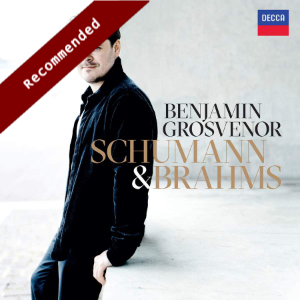
Benjamin Grosvenor (piano)
Robert Schumann (1810-1856)
Kreisleriana Op.16 (1838)
Romance Op.28 No.2 (1839)
Blumenstück Op.19 (1839)
Quasi variazioni from Piano Sonata No.3 Op.14 (1853)
Abendlied No.12 from 12 Klavierstücke für kleine und grosse Kinder for piano duet Op.85 (1849, arr. Benjamin Grosvenor)
Clara Schumann (1819-1896)
Variations on a theme by Robert Schumann Op.20 (1853)
Johannes Brahms (1833-1897)
Three Intermezzi Op.117 (1892)
rec. 2022, Potton Hall, UK
Decca 4853945 [86]
Never one just to be satisfied with the well-trodden path Benjamin Grosvenor adds a work of Clara Schumann and his own arrangement of short piano duet morsel to this very generously packed recital of Schumann and Brahms. Even his choice of Schumann’s Blumenstück is slightly unusual; Grosvenor grew up with Vladimir Horowitz’s recording of the quasi variazioni from the F minor Sonata and Horowitz had the Blumenstück in his repertoire at the same time he was recording the variations so there is that connection.
Schumann’s Kreisleriana is the main work here, its turbulence and fantasy contrasting with the late Brahms Intermezziand the variations at the recital’s heart. Its internal contrasts are clear in Grosvenor’s passionate recording; Florestan and Eusebius, tempestuous and lyrical are both present in the opening of the first movement but it is the hushed middle section that impresses here, Eusebius musing that such different temperaments can achieve such harmony. At times Grosvenor employs a delicious rubato; in the second fantasy, sehr innig und nicht zu rasch, it is notable when the texture is richer and the melody is assigned to the left hand with very gentle surges as the phrase grows. Quite intense ritardandi and real Adagios show which character is uppermost here even with the extrovert Florestan in full flight in the two intermezzi. This continues throughout with Grosvenor’s glorious sense of line and ferocious technical command balancing mood effortlessly; gripping bass lines, voices singing out in duet and trio and moments of heartbreaking stillness such as the end of the fourth fantasy. The seventh fantasy is astonishing in its fury but never veers out of control and the playful final movement seems to mix up the roles a little, Florestan trying his hand at the lyrical, passionately done of course, whilst Eusebius busies himself with the playful motifs above. A wonderful reading throughout.
Though Kreisleriana was ultimately dedicated to Chopin it was written with Clara in mind; in 1838 he wrote to her I shall dedicate them to you; yes, to you and nobody else and you will smile so sweetly when you see yourself in them.The three Romances op.28 needed no such dedication; Clara immediately claimed them as her own especially the middle one, which is the most beautiful love duet. Grosvenor’s beautifully poised performance leads to three sets of variations and though only two are named as variations they are all alike in the connection they have to Clara. Schumann’s Blumenstück features a falling note figure recognisable as his Clara motif from his earlier Carneval op.9. Was it Clara’s love through rose-tinted glasses that allowed her to ignore Schumann’s description of his Blumenstück,along with his arabeske, as delicate salon pieces fit only for ladies to play. It is a set of variations, really two variations in one, that perhaps doesn’t have enough variety to endear it to music lovers in the way that Kreisleriana, Carneval, the C major Fantasy and other works have but there is plenty of attractive music here. No such problem in the compact third movement of his F minor Sonata, a set of variations on the same falling motif but with greater variety of mood and texture in its short span. It is often heard removed from the rest of the Sonata and like Grosvenor I grew up with it in the version by Horowitz and later Katsaris. Grosvenor bows to neither in his warm lyricism and depth of expression. After a short interlude in the form of his own arrangement of the Abendlied from his piano duet collection op.85, a work that Clara often included in her recitals according to booklet and a delicious treat here, Grosvenor plays Clara’s own Variations on a theme by Robert Schumann, written in 1853. She based it on the first Album leaf from the Bunte Blätter op.99 which, despite the high opus number, collects together earlier pieces and this Albumblatt dates from around the same time as the Blumenstück. These are terrific variations, broad in their imagination and use of texture and though they are virtuosic I am reminded more of Mendelssohn’s Variations serieuses in style and mood rather than the filigree fluff that often represented variations at the time. The variations often alternate lyrical and virtuosic; a beautifully chromatic third variation is followed by a variation in running triplets with the melody lying in the left hand and a gentle canon is followed by a vigorous octave variation. Variation seven is a marvellously woven tapestry of decoration over the theme and after a lovely change from the minor to major key Schumann brings the variations to a tranquil close. Brahms used the same piece as the basis for his variations op.9, his own homage to Schumann, but it is much later music with which Grosvenor ends the recital, the three intermezzi op.117. He doesn’t linger indulgently and in the C sharp minor intermezzo the con moto tempo marking is evident without the whole being rushed. The balance between this and the central A major is well judged as are the bells ringing out of the texture. The sense of desolation in the central section of the first intermezzo is a highlight here for me but all three are wonderful readings. This well thought out recital is recorded in sumptuous sound and Grosvenor’s playing is impeccable. First class.
Rob Challinor
Help us financially by purchasing from




















